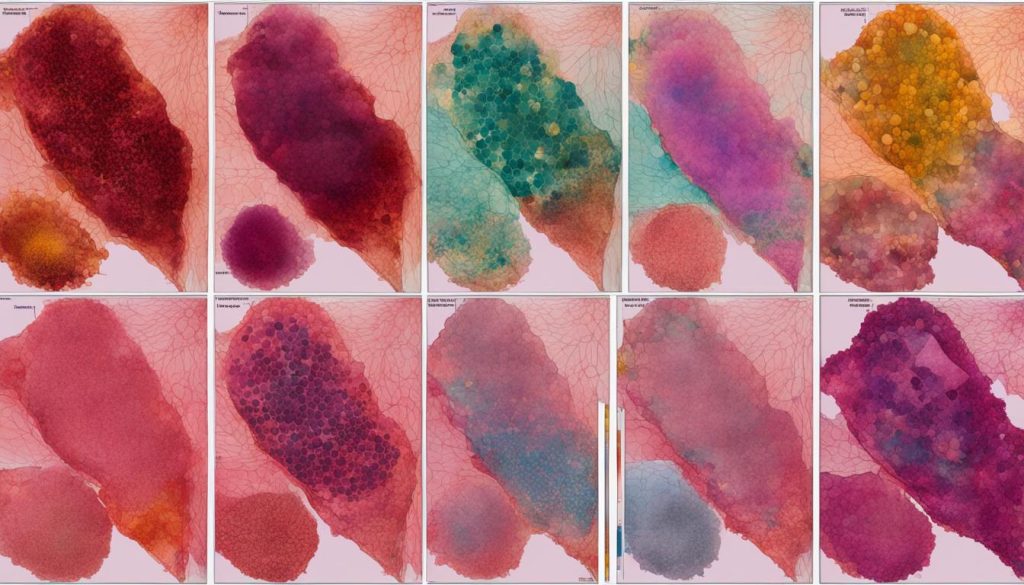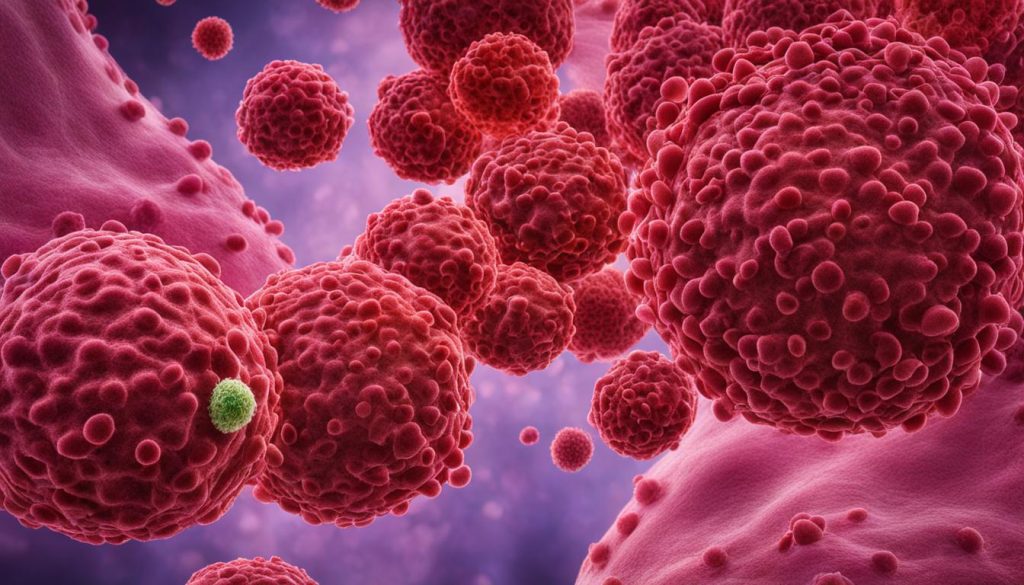After a breast cancer diagnosis, doctors determine the stage of the cancer to understand its severity and plan the most effective treatment. The American Joint Committee on Cancer (AJCC) TNM system is commonly used to stage breast cancer. It takes into account factors such as the size of the tumor, lymph node involvement, the presence of distant metastasis, and biomarkers such as estrogen receptor (ER) status, progesterone receptor (PR) status, and HER2 status. The stages range from 0 (non-invasive carcinoma in situ) to IV (cancer that has spread to distant organs). Staging helps predict a patient’s prognosis and guides treatment decisions.
Understanding the different stages of breast cancer is crucial for determining the appropriate treatment approach and predicting a patient’s prognosis. By accurately staging breast cancer, healthcare professionals can develop personalized treatment plans tailored to each patient’s specific needs. Regular screenings, early detection, and timely intervention can significantly improve the outcomes for individuals diagnosed with breast cancer.
Determining the Stage of Breast Cancer
When it comes to breast cancer, determining the stage is crucial in understanding the extent of the disease and planning the most effective treatment. There are two methods for determining the stage of breast cancer: clinical staging and pathological staging.
In clinical staging, doctors use pre-surgery tests such as physical exams, imaging scans, and biopsies to evaluate the size of the tumor, lymph node involvement, and the presence of distant metastasis. This initial assessment helps guide treatment decisions and estimate the prognosis.
On the other hand, pathological staging is done after surgical removal of the tumor and examination of the tumor and lymph nodes under a microscope. This provides a more accurate assessment of the cancer’s characteristics and helps refine the treatment plan.
Clinical Stage and Pathological Stage
The TNM system is used in both clinical and pathological staging. It stands for Tumor, Node, and Metastasis. The T category describes the size and extent of the tumor, the N category indicates lymph node involvement, and the M category signifies the presence of distant metastasis.
By combining these categories, doctors can determine the overall stage of breast cancer, which ranges from 0 to IV. Staging not only helps in predicting a patient’s prognosis but also provides valuable information for selecting the most appropriate treatment options.


Breast Cancer Staging Categories
Breast cancer staging is crucial for determining the severity of the disease and planning the most effective treatment. The stages of breast cancer are categorized as stage 0, I, II, III, and IV, each representing a different level of tumor progression and spread. Understanding these stages is essential in guiding treatment decisions and predicting a patient’s prognosis.
Stage 0 Breast Cancer
Stage 0 breast cancer, also known as carcinoma in situ, refers to non-invasive cancer that has not spread beyond the ducts or lobules of the breast. It is confined to its original location and has not invaded surrounding tissues or lymph nodes. Although stage 0 breast cancer is not life-threatening, it may increase the risk of developing invasive breast cancer in the future. Early detection and appropriate treatment are crucial to prevent its progression.
Stage I Breast Cancer
Stage I breast cancer is characterized by the presence of a small tumor, measuring 2 centimeters or less, that has not spread to the lymph nodes. It is an early stage of cancer and is typically considered highly treatable. Timely intervention and effective treatment options, such as surgery, radiation therapy, and hormone therapy, can yield favorable outcomes for individuals diagnosed with stage I breast cancer. Regular screenings play a key role in detecting cancer at this early stage.
Stage II Breast Cancer
Stage II breast cancer can be further categorized into stage IIA and stage IIB, depending on the size of the tumor and lymph node involvement. In stage IIA, the tumor is either 2 centimeters or smaller and has spread to the lymph nodes, or it is larger than 2 centimeters but not exceeding 5 centimeters and has not spread to the lymph nodes. In stage IIB, the tumor is larger than 2 centimeters but not exceeding 5 centimeters and has spread to the lymph nodes, or it is larger than 5 centimeters and has not spread to the lymph nodes. Treatment options for stage II breast cancer may include surgery, radiation therapy, chemotherapy, and targeted therapy, depending on individual factors and the specific characteristics of the cancer.
Staging breast cancer allows healthcare professionals to tailor treatment plans to individual patients, considering factors such as tumor size, lymph node involvement, and biomarker status. It helps predict prognosis and guides decisions regarding surgery, radiation therapy, chemotherapy, hormone therapy, and targeted therapy. Regular screenings and awareness of breast cancer symptoms remain crucial in detecting cancer at its earliest stages, improving the chances of successful treatment outcomes.
Advanced Stages of Breast Cancer
When breast cancer progresses to advanced stages, it poses greater challenges and risks for patients. Stage III breast cancer represents locally advanced cancer that has spread to the lymph nodes and potentially to nearby tissues. This stage is further categorized based on the number of lymph nodes involved and the presence of internal mammary lymph node involvement.
In stage III breast cancer, the tumor may be larger and may have spread beyond the breast. The cancer may have invaded the chest wall or the skin, but it has not yet spread to distant organs. The extent of lymph node involvement helps determine the specific subcategory within stage III, which can guide treatment decisions.
Treatment for Stage III Breast Cancer
Treatment for stage III breast cancer typically involves a combination of therapies, including surgery, radiation therapy, chemotherapy, and targeted therapy. The goal is to eliminate or shrink the tumor, eradicate any cancer cells in the lymph nodes, and prevent the spread of cancer to other parts of the body. The specific treatment plan may vary based on individual factors such as tumor characteristics, overall health, and patient preferences.
Stage IV breast cancer, also known as metastatic breast cancer, is the most advanced stage. At this stage, the cancer has spread to distant organs such as the lungs, liver, bones, or brain. Managing stage IV breast cancer focuses on controlling the disease, relieving symptoms, and improving quality of life. Treatment options may include chemotherapy, hormone therapy, targeted therapy, immunotherapy, and palliative care.


Early Detection and Support
Early detection plays a crucial role in improving outcomes for breast cancer patients. Regular screenings, self-examinations, and awareness of the potential signs and symptoms are essential. It is important for individuals to seek prompt medical attention if they notice any changes in their breasts or have concerns.
Additionally, a strong support system is invaluable for individuals diagnosed with advanced stages of breast cancer. Emotional support from loved ones, counseling, support groups, and access to resources can help patients navigate the challenges and make informed decisions about their treatment and overall well-being.
Factors Considered in Stage Grouping
When determining the stage of breast cancer, healthcare professionals consider several factors in addition to the TNM categories. These factors provide a more comprehensive understanding of the cancer and help guide treatment decisions.
Estrogen Receptor Status and Progesterone Receptor Status
Estrogen receptor (ER) status and progesterone receptor (PR) status are key biomarkers that indicate whether the cancer cells have receptors for the hormones estrogen and progesterone. These receptors play a crucial role in the growth of breast cancer cells. If the cancer is hormone receptor-positive, it means the cells rely on these hormones for growth. Hormone receptor-positive breast cancers can be treated with hormone therapy to block the effects of estrogen and progesterone on the cancer cells.
HER2 Status
The HER2 status of breast cancer refers to the presence of a protein called HER2, which can affect the growth of cancer cells. If breast cancer is HER2-positive, it means the cancer cells have an excess of this protein, promoting their growth and division. HER2-positive breast cancers can be treated with targeted therapies that specifically inhibit the HER2 protein, reducing the growth and spread of cancer cells.
Tumor Grade
The tumor grade is another important factor in stage grouping for breast cancer. It refers to the appearance of the cancer cells under a microscope and indicates how abnormal they look compared to normal cells. Tumor grade helps determine the aggressiveness of the cancer and how likely it is to grow and spread. Higher-grade tumors tend to be more aggressive and may require more intensive treatments.
By considering these factors – estrogen receptor status, progesterone receptor status, HER2 status, and tumor grade – healthcare professionals can accurately stage breast cancer and develop personalized treatment plans tailored to each patient’s specific needs. This comprehensive approach ensures that patients receive the most appropriate and effective treatments for their individual circumstances.
Conclusion
Understanding the different stages of breast cancer is crucial for determining the appropriate treatment approach and predicting a patient’s prognosis. By accurately staging breast cancer, healthcare professionals can develop personalized treatment plans tailored to each patient’s specific needs. Regular screenings, early detection, and timely intervention can significantly improve the outcomes for individuals diagnosed with breast cancer.
When it comes to breast cancer treatment, the stage of the cancer plays a vital role. It helps physicians decide which treatment options are the most effective and appropriate for the patient’s condition. Early-stage breast cancer may be treated with surgery, radiation therapy, and hormone therapy, while more advanced stages may require a combination of treatments like chemotherapy and targeted therapies.
Prognosis varies depending on the stage of breast cancer and individual factors. Generally, the prognosis for early-stage breast cancer is favorable, with a high chance of survival. However, as the cancer progresses to advanced stages, the prognosis becomes more challenging. It is important for patients to work closely with their healthcare team to understand their options, make informed decisions, and receive the most appropriate treatment.
FAQ
How is breast cancer staged?
Breast cancer is staged using the American Joint Committee on Cancer (AJCC) TNM system, which takes into account factors such as tumor size, lymph node involvement, the presence of distant metastasis, and biomarker status.
What is the difference between clinical staging and pathological staging?
Clinical staging is based on pre-surgery tests, while pathological staging is determined through surgical examination of the tumor and surrounding lymph nodes.
What are the different stages of breast cancer?
The stages of breast cancer include stage 0 (carcinoma in situ), stage I, stage II, stage III, and stage IV.
What is stage 0 breast cancer?
Stage 0 breast cancer refers to non-invasive carcinoma in situ, which has not spread beyond the ducts or lobules of the breast.
What is stage I breast cancer?
Stage I breast cancer is characterized by a small tumor (2 cm or less) that has not spread to the lymph nodes.
What is stage II breast cancer?
Stage II breast cancer includes tumors larger than 2 cm but not exceeding 5 cm, with or without lymph node involvement.
What is stage III breast cancer?
Stage III breast cancer represents locally advanced cancer that has spread to the lymph nodes and possibly to other tissues near the breast.
What is stage IV breast cancer?
Stage IV breast cancer, also known as metastatic breast cancer, is characterized by the spread of cancer to distant organs such as the lungs, liver, bones, or brain.
What factors are considered in stage grouping for breast cancer?
Factors such as estrogen receptor (ER) status, progesterone receptor (PR) status, HER2 status, and tumor grade are considered in stage grouping for breast cancer.
How does staging help in breast cancer treatment?
Staging helps predict a patient’s prognosis and guides treatment decisions, allowing healthcare professionals to develop personalized treatment plans tailored to each patient’s specific needs.
